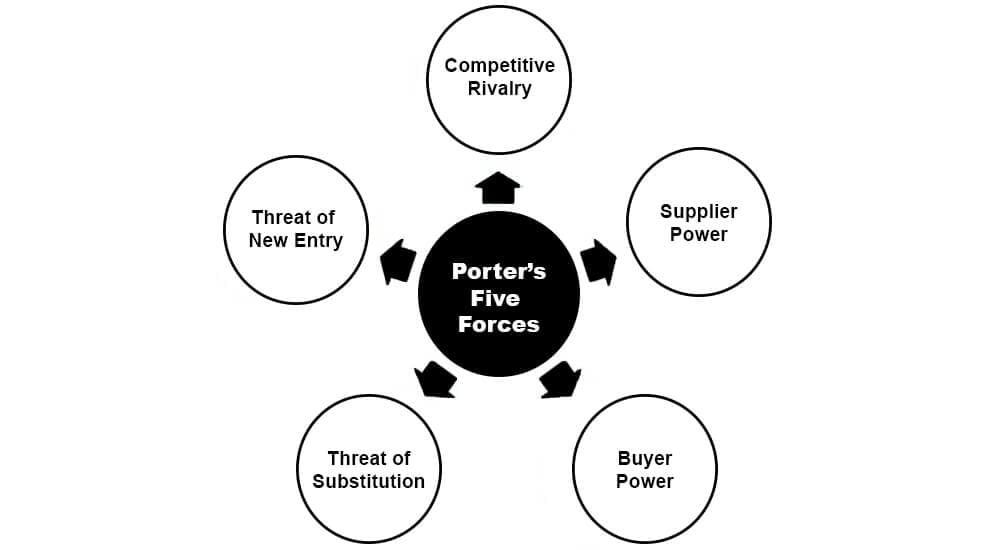In 1979, Michael E Porter of Harvard Business School created Porter’s Five Forces of Competitive Position Analysis, a basic model for examining a corporate organization’s economic power and standing.
Companies often check on their rivals, but in his Harvard Business Review essay, “How Competitive Forces Shape Strategy,” Porter pushed them to go beyond competitors’ behavior.
This analysis can also find power regions, address deficiencies, and prevent errors. Porter’s five forces have varying degrees of power depending on the industry and impact pricing, expenses, and capital investments.
What is Porter’s Five Forces Model?
The idea is that five forces determine a market’s competitive strength and appeal. Porter’s model assists in finding the strength of an organization’s competing position and the power that a company wishes to achieve.
Researchers frequently use Porter’s five forces to determine whether new items or services can succeed. Managers utilize the paradigm to assess the economic framework of the industry and in strategic decision-making.
Michael emphasized that these five forces should not be confused with more transient elements, like industrial rates of development, government involvement, and technology advancements. These are ephemeral elements, but the five forces are fundamental components of an industry’s framework.
Porter’s Five Forces

Porter’s five forces are:
- Competitive Rivalry
- Supplier Power
- Buyer Power
- Threat of Substitution
- The threat of New Entry
Competitive Rivalry
This factor includes how many competitors you have, their strengths, details, product quality, and service comparisons.
In an industry with extreme rivalry, companies aggressively cut prices and launch high-impact marketing campaigns. This makes it easy for suppliers and buyers to go elsewhere if they don’t get an acceptable deal.
When competition is minimal, or no one offers products or services similar to yours, you’ll have enormous competitor power and healthy profits.
Examples
In the UK, customers can choose from over 87,000 physical grocery stores. Price competition is fierce, and retailers have to cut costs to attract customers.
Supplier Power
This is how comfortably suppliers can increase prices. Factors that impact it includes how many suppliers shut their doors, the uniqueness of the product or service, and the costs for changing suppliers.
The more suppliers to choose from, the easier it is to find a cheaper alternative. Contrarily, the fewer suppliers there are, the more you depend on them. Suppliers with a stronger position, and can increase the price. Buying goods at a higher price affects profitability.
Examples
Unilever is famous for its broad range of household brands like Marmite and Ben & Jerry’s. Supermarket chain Tesco felt Unilever’s bargaining power in 2016 when it refused to increase Unilever’s cost prices.
An identical confrontation kept shelves empty in 2018 when Nestle and German supermarket chain Edeka could not agree on standard trade terms.
Buyer Power
If the buyers are lower than the number of suppliers, they have buyer power. In this case, buyers can switch easily to new and affordable competitors, driving down prices.
The buyers’ power decreases with more customers and little competition. Pricing the product, attracting customers, and protecting the brand requires great skill.
Examples
The tech giant Apple showed how their powerful buyers made its leading supplier redundant. With its new MacBook in 2020, they put an end to Intel chips in their products.
Threat of Substitution
This refers to the likelihood of the customers finding a different solution. For example, if you deliver a unique software product that automates a necessary process, people may supersede it manually or by outsourcing it.
A comfortable and affordable substitution can weaken your position and threaten your profitability.
Examples
Amazon unleashed the Kindle in 2007. Amazon was laughed at by established publishers in the book industry.
These big companies didn’t recognize the threat to their business model; they never considered that consumers would prefer an electronic gadget over bound books.
According to some estimates, Amazon sells over 95 million eBooks per year in the UK.
Threat of New Entry
New entrants in an industry bring new capabilities. The seriousness of the threat depends on the industry’s barrier to entry. The higher the hurtle, the smaller the danger for existing players.
Examples of hindrances to entry are the need for economies of scale, large capital requirements (e.g., significant investments in marketing or R&D), government policies, and limited access to distribution channels.
Example
The threat of less experienced competitors entering the airline industry is medium to high. It takes upfront investments to start an airline company. Moreover, new entrants require licenses, insurances, distribution channels, and other qualifications that are not easy to obtain.
Features of Porter’s Five Forces Model
Porter’s five forces offer methods for in-depth industry assessment, assisting organizations in understanding their competitive situation and formulating strategic plans.
Porter’s five forces model has the following features:
- Competition-oriented
- Examines current industries
- Respects the industry’s earning prospects
Implementing Porter’s Five Forces
The five forces of Porter’s model can raise the costs of digital businesses and make them less competitive.
These include:
- The competitive nature of a marketplace.
- The danger of new entrants.
- The bargaining ability of buyers and suppliers.
If a business is entering a digital industry, they will need to tabulate this information as they evaluate the competitiveness of the marketplace. If the competition is high, prospects are not promising. But low competition provides an opportunity.
Low barriers to entry can be a cost advantage. But if the business is already in the industry, a slight hurdle to entry will threaten it. A higher cost is a protective barrier, giving businesses fewer competitors.
Analysis
The first step is to understand and gather the relevant information. This data is used to check the company’s position in the industry.
It is a qualitative parameter that most investors ignore.
Investors must understand these forces before they start examining a company. Learning more about the company will lead to better investment decisions.
Advantages of Porter’s Five Forces
Competition in the Industry
Porter’s five forces help gauge the danger of new entrants, the threat of substitution, supplier power, and buyer power. Together, these factors are the competitive rivalry of the industry. It helps the analyst understand the industry’s current competition and adjust their corporate strategy.
Strengths and Threats
Porter’s five forces explain the supplier and buyer forces with the threat of new entrants and alternate products. Management will determine the company’s strengths and weaknesses. They will take preventive action against threats while enhancing their strengths.
Holding of Power
Porter’s five forces are related to three entities, suppliers, buyers (consumers), and competitors. The analysis shows which entities hold more power and which has less, so businesses can decide on the best strategies to handle them.
Expanding Business
Porter’s five forces furnish the power of suppliers and buyers in the industry. This analysis helps the company decide to acquire more buyers and suppliers and expand its power. Or they can contract their consumer side value chain.
Porter’s five forces helps the company understand the competitive rivalry, so they can consider acquiring a competitor and reducing the risk of competition.
The Corporate Risk
Porter’s five forces provide invaluable insights into the suppliers’ power, the power of consumers, and the power of competitors. This information helps businesses understand corporate risk. Then they develop responses.
Corporate Strategy and Vision
This concept enables a company to make strategic conclusions by finding the best way to create value. Porter’s five forces will provide helpful information to accurately create a corporate strategy by considering the impact of external forces.
Disadvantages of Porter’s Five Forces
Focuses on Only Five Factors
Porter’s paradigm concentrates on five factors; it doesn’t consider others like technology or business strategies.
For example, technological evolution is one of the greatest threats for companies across all industries. The five factors method does not consider external forces, such as taxation policies, government policies, environmental impact, and cross-border business risk.
Quantitative Dimensions
There is no built-in method for analyzing external factors quantitatively. This mechanism does not provide a quantitative idea or consequences of the five forces. Also, it cannot distinguish the most and least important ideas.
Large Companies
Using this analytical framework for a company with an extensive product portfolio that operates in different market segments is challenging. The five factors only analyze a company in a single industry.
Starting Point for the Analysis
Porter’s five forces is an easy tool containing external factors that can be valuable or drawback for a company. This mechanism is suitable as the starting point for a deeper investigation. It leads to understanding the initial position of the company but cannot provide an in-detail inquiry alone.
Not Applicable for all Industries
Porter’s five forces do not apply to all industries. Nonprofit companies cannot use this process for analysis. This framework does not help research and development activities.
Business Risks
External risk factors like foreign exchange instabilities, legal constraints, fast technological evolutions, and fluctuations in interest rates are not evaluated. These are significant in determining the business risks to the company.
Conclusion
Every organization aspires to be at the forefront of their industry. Focusing on internal factors, considering rivals, and analyzing market dynamics can help organizations achieve their objectives. Porter’s five forces allow companies to make informed and effective decisions.

Great summary helps to simplify understanding.
Its is very simplified for great understanding